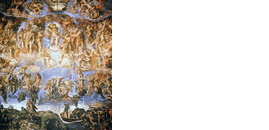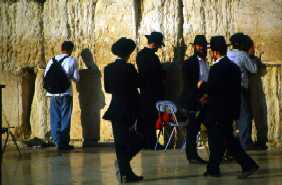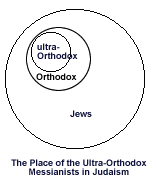
|
|
|
|
|
Class
Prep
|
|
|
|
- The
Zionist Utopia & Modern Jewish Messianism
-

- Today's readings introduce the trajectories of messianic speculation
in Judaism after the destruction of the Second Temple in 70 C.E.,
with a special emphasis on the variety of positions taken today.
-
- Messianic speculation was of course prominent in antiquity,
particularly from about 200 B.C.E. to 200 C.E. The most famous
messianic figures of that period were Jesus "the Christ"
(Greek for messiah, early first century CE) and the Jewish guerrilla
leader Simon Bar Kokhba of the early second century CE. When
Bar Kokhba's Revolt against Rome was crushed in 135 C.E., the
majority of Jews regrouped around their teachers ("rabbis"),
who in turn steered a course that focused on the interpretation
of the Torah or law rather than on apocalyptic speculation. In
their minds, apocalyptic had discredited itself by breeding the
Christian heresy and the failed Second Revolt.
-
- There were times over the centuries when messianic speculation
peaked within Judaism, notably the brief messianic career of the
seventeenth-century Sabbatai Sevi, whose popularity among Jews
diminished when he converted to Islam. New messianic
hopes also grew as European Jews came under increasing persecution
in the eighteenth and nineteenth centuries. This time
also saw the rise of a revitalization movement, the Orthodox or
Hasidic denomination, which sought to reform rabbinic Judaism
from within. In the late nineteenth and early twentieth
century, yet another utopian impulse came to birth in the Zionist
Movement; secular and religious branches had different frameworks
for advocating a Jewish homeland somewhere in the world, but all
worked together to try to make it happen. The Holocaust
during World War II (1939-1945) and the creation of the State
of Israel in 1948 created opportunities for all Jews to return
to Israel--secular Jews, communists, and practicing Jews from
the Orthodox, Reform and Conservative denominations.
-
- The
World Zionist Organization, as defined by the Jewish
Virtual Library (a division of the American-Israeli Cooperative
Enterprise).
- Homeward
Bound - The Zionist Movement Pavilion of the Zionist
Exhibition, sponsored by Hagshama: Department of the World Zionist
Organization.
- Israel
and Zionism - The Pedagogic Center of the Department
for Jewish Zionist Education; maps, timelines, important names,
but only current to 1997.
-
- One might think at first glance that all Israelis, or all Jews,
welcomed the creation of the State of Israel and the Zionist program. In
fact, there is a spectrum of opinion among Jewish groups. Aviezer
Ravitzky, Chair of the Department of Jewish Thought at Hebrew
University, has recently examined a small segment of this spectrum
- those Jewish groups that espouse an ultra-orthodox form of Judaism.1 In
this segment of the population, he finds that the rejection or
acceptance of Zionism has to do with the group's messianic beliefs. At
one end of the spectrum are the radical anti-Zionists, who believe
Zionism is antimessianic because it usurps the role of the messiah. The
most important of these groups are:
-
- Neturei
Karta - browse this web site to find the reasons why
the group opposes Zionism. Take notes on the messianic
beliefs of the group.
- Satmar
Hasidim - search the University of Virginia New Religious
Movements page on Hasidim for a description of the Satmar branch.
- Edah Haredit
-
- On the other end of the spectrum are those groups that embrace
the creation of Israel and Zionism as part of the messianic process. The
most important group in this category is Gush Emunim (Bloc of
the Faithful) and its leader, Rabbi Abraham Isaac Kook. Members
of this movement are numbered among the Jewish settlers and have
been involved in religious violence targeted against Palestinians.
-
- Gush
Emunim - as described by University of Calgary Religious
Studies Professor Eliezer Segal, for his course, Judaism in
the Modern World.
-
- Similar to Gush Emunim are other groups who believe it incumbent
on Jews to prepare the ground for the messiah, and who plan to
do so by rebuilding the Jewish Temple on Temple Mount (where the
Moslem Dome of the Rock and al-Aqsa Mosques currently stand). They
understand this activity as a necessary precursor to the messiah's
arrival, a feature they share with Christian fundamentalists (as
we will see a few days.
-
-
 In
between these two extremes are the majority of ultra-Orthodox
or Haredi Jews, who view Zionism and consequently the State of
Israel as religiously neutral. This viewpoint is espoused
by the majority of ultra-Orthodox Jews, who as a whole number
only a small minority of Jews worldwide. One of the
most important of the centrist groups is the Lubavitch Hasidim,
about whom you will be reading today. Like the other
centrist Haredim, the Lubavitchers believe that the exile of the
past 2000 years did not end with the creation of the State of
Israel, but rather will end only with the advent of the messiah.
The Lubavitchers diverge from the other centrist groups because
they alone began to believe in the 1990s that their rebbe might
soon manifest as the messiah. In
between these two extremes are the majority of ultra-Orthodox
or Haredi Jews, who view Zionism and consequently the State of
Israel as religiously neutral. This viewpoint is espoused
by the majority of ultra-Orthodox Jews, who as a whole number
only a small minority of Jews worldwide. One of the
most important of the centrist groups is the Lubavitch Hasidim,
about whom you will be reading today. Like the other
centrist Haredim, the Lubavitchers believe that the exile of the
past 2000 years did not end with the creation of the State of
Israel, but rather will end only with the advent of the messiah.
The Lubavitchers diverge from the other centrist groups because
they alone began to believe in the 1990s that their rebbe might
soon manifest as the messiah.
-
-
- The second article you will read by Simon Dein focuses
on one group that Ravitzky mentions, the Lubavitcher Hasidim (who
are mostly concentrated in New York), and tells the story of how
they dealt with a failed messianic hope. Juergensmeyer
discusses the radical right wing in Israel who, like Al-Qaida
and Christian terrorists, resort to violence to defend their religious
beliefs. Finally, Daniels provides a survey of apocalypticism
across major world religions that provides the "big picture"
within which all historical iterations may be placed.
-
- As you read these articles, consider the following issues and questions:
-
-
- What political or military events influenced Ultra-Orthodox
Jewish speculation about the messiah, and did the various
groups respond in the same way to these events?
- Do all of the Ultra-Orthodox groups Ravitzky mentions agree
that the creation of the State of Israel is a good thing?
- Dein applies the sociological theory of cognitive dissonance
to the experience of failed prophecy. He wants
to understand why people continue to believe when their beliefs
prove manifestly untrue. According to Dein, what
did the Lubavitchers believe about the messiah, and why/how
did the group withstand the failure of their hope?
- According to Juergensmeyer, what recent incidents of violence
can be attributed to Jewish religious fervor? What
is the connection between these fervent beliefs and the Jewish
Bible (if any)?
- Daniels provides a broad survey of apocalypticism and millennialism
in world religions. Does he add any new features
to our definition of "apocalyptic"?
-
- 1 Messianism,
Zionism, and Jewish Religious Radicalism, trans. Michael Swirsky
and Jonathan Chipman, Chicago Studies in the History of Judaism. Chicago:
University of Chicago Press, 1996; original, Tel Aviv: Am Oved,
1993. These groups are all branches of Hasidic Judaism,
which you can learn about at the University of Virginia's New
Religious Movements web site.
-
-
- Assigned Readings
- Primary: Selected web sites; see links above
- Secondary: Ravitzky, "The Messianism of Success
in Contemporary Judaism"; Dein, "What Really Happens
When Prophecy Fails: The Case of Lubavitch"; Juergensmeyer
44-59; Daniels 19-51
- Optional: Daniels, "Nazism: Adolf Hitler and Mein
Kampf"; Ellwood, "Nazism as a Millennialist Movement"
(ERes)
-
-
- Further Reading
- See the Course Bibliography on Contemporary
Jewish Messianism & Zionism.
-
-
- Links
-
-
-
- Sources
- Photograph: C. Murphy, "Men's Section of Western Wall,
Temple Mount, Jerusalem (O-196)," 1994.
|
|
|
|
|
